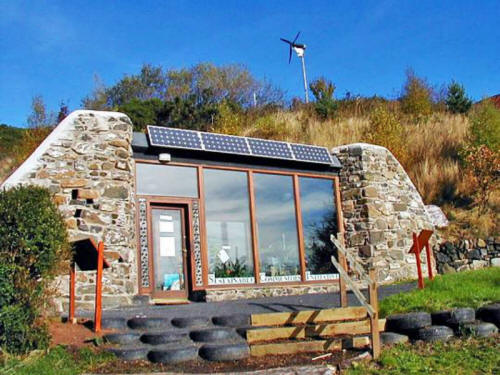Across a two acre stretch in
New Mexico, a provocative experiment is taking place.
These isn't the kind of test
involving nuclear devices that we've come to expect in
the desert, but one that attempts to imagine a
sustainable society in the aftermath of such weaponry.
After all, a
post-apocalyptic landscape would require highly
sustainable housing, and that's just what designer and
ex-athlete Tom Duke has constructed.
His unorthodox
efforts are the subject of the documentary titled 'Earthships.'
The houses look like futuristic throwbacks; part
conventional and part science fiction. They're
constructed with items most people disregard as useless
trash.
Glass bottles are used like
bricks, sand filled tires lay the foundation for each
structure, aluminum cans decorate the walls and spark a
feeling of the majestic when met by the orange rays of
the sun.
Inside, the walls are specially designed to absorb
sunlight during the day, and expel heat at night.
Thriving greenhouses,
innovative ventilation systems and rows of windows
further ensure constant and comfortable in-door
temperatures. Gardens grow bounties of bananas, grapes
and figs.
Rainwater is collected and
stored in wells, and later drained for use in the shower
before being transferred to plants, toilets and outdoor
vegetation.
Yes, in an Earthship, even
the toilet water is reusable.
The concept may sound wacky to some, but it's catching
on larger pockets of the population, particularly as the
modern world seems to veer deeper into chaos.
Encouragingly for them, the cost of these houses has
decreased substantially.
The top-of-the-line model
containing all the amenities - a structure known as the
BMW of Earthships - sells for roughly the same cost as a
traditional family home, but the energy savings incurred
over years makes the investment even more appealing.
Duke guides through multiple housing models throughout
the course of the film, explaining the special features
in each, as well as the philosophies behind their
construction.
A seemingly average family
man with a unique and valuable vision, he flies in the
face of conventional wisdom regarding those who live off
the grid.
As told in Earthships, his
story is not one of apocalyptic gloom and doom, but of
hope, possibility and life-enhancing innovation.
Source


